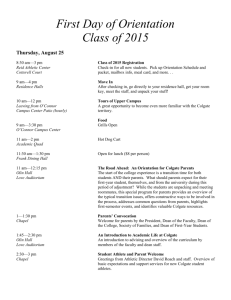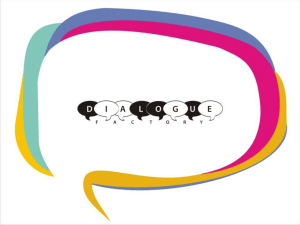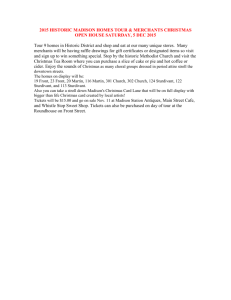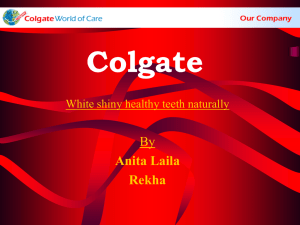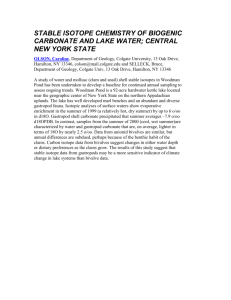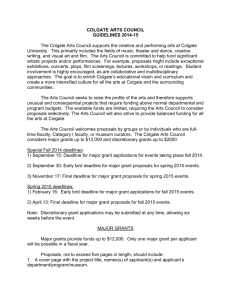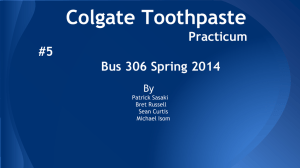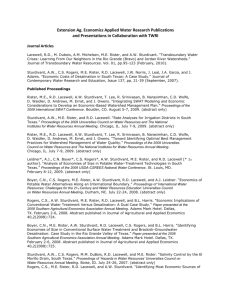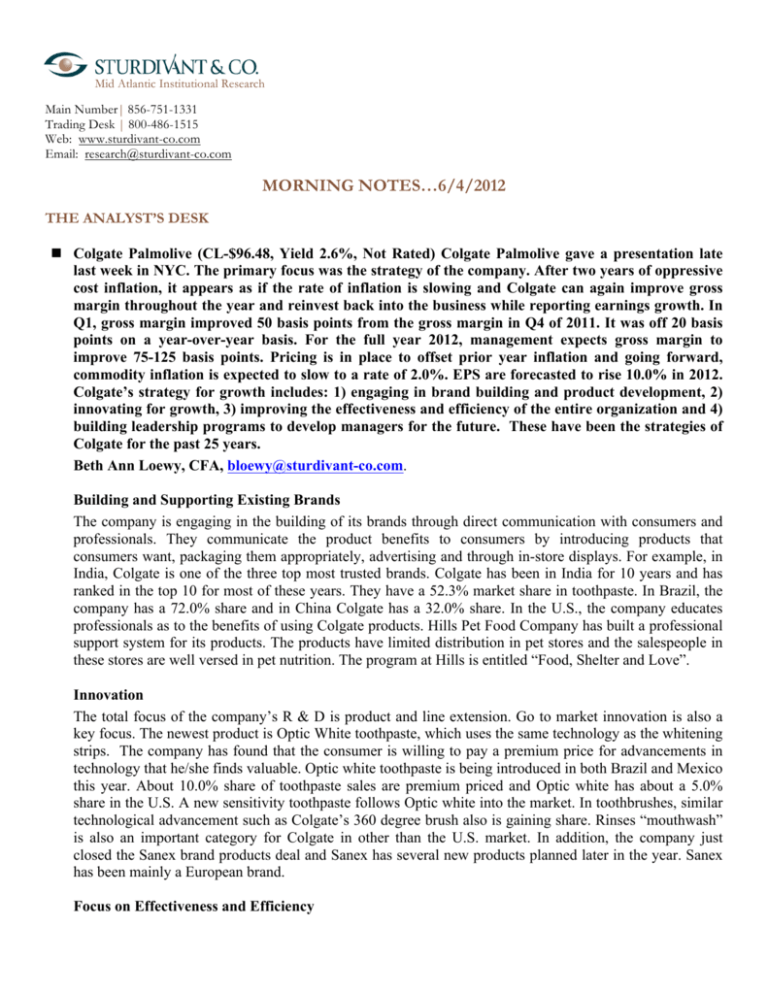
Mid Atlantic Institutional Research
Main Number| 856-751-1331
Trading Desk | 800-486-1515
Web: www.sturdivant-co.com
Email: research@sturdivant-co.com
MORNING NOTES…6/4/2012
THE ANALYST’S DESK
n Colgate Palmolive (CL-$96.48, Yield 2.6%, Not Rated) Colgate Palmolive gave a presentation late
last week in NYC. The primary focus was the strategy of the company. After two years of oppressive
cost inflation, it appears as if the rate of inflation is slowing and Colgate can again improve gross
margin throughout the year and reinvest back into the business while reporting earnings growth. In
Q1, gross margin improved 50 basis points from the gross margin in Q4 of 2011. It was off 20 basis
points on a year-over-year basis. For the full year 2012, management expects gross margin to
improve 75-125 basis points. Pricing is in place to offset prior year inflation and going forward,
commodity inflation is expected to slow to a rate of 2.0%. EPS are forecasted to rise 10.0% in 2012.
Colgate’s strategy for growth includes: 1) engaging in brand building and product development, 2)
innovating for growth, 3) improving the effectiveness and efficiency of the entire organization and 4)
building leadership programs to develop managers for the future. These have been the strategies of
Colgate for the past 25 years.
Beth Ann Loewy, CFA, bloewy@sturdivant-co.com.
Building and Supporting Existing Brands
The company is engaging in the building of its brands through direct communication with consumers and
professionals. They communicate the product benefits to consumers by introducing products that
consumers want, packaging them appropriately, advertising and through in-store displays. For example, in
India, Colgate is one of the three top most trusted brands. Colgate has been in India for 10 years and has
ranked in the top 10 for most of these years. They have a 52.3% market share in toothpaste. In Brazil, the
company has a 72.0% share and in China Colgate has a 32.0% share. In the U.S., the company educates
professionals as to the benefits of using Colgate products. Hills Pet Food Company has built a professional
support system for its products. The products have limited distribution in pet stores and the salespeople in
these stores are well versed in pet nutrition. The program at Hills is entitled “Food, Shelter and Love”.
Innovation
The total focus of the company’s R & D is product and line extension. Go to market innovation is also a
key focus. The newest product is Optic White toothpaste, which uses the same technology as the whitening
strips. The company has found that the consumer is willing to pay a premium price for advancements in
technology that he/she finds valuable. Optic white toothpaste is being introduced in both Brazil and Mexico
this year. About 10.0% share of toothpaste sales are premium priced and Optic white has about a 5.0%
share in the U.S. A new sensitivity toothpaste follows Optic white into the market. In toothbrushes, similar
technological advancement such as Colgate’s 360 degree brush also is gaining share. Rinses “mouthwash”
is also an important category for Colgate in other than the U.S. market. In addition, the company just
closed the Sanex brand products deal and Sanex has several new products planned later in the year. Sanex
has been mainly a European brand.
Focus on Effectiveness and Efficiency
The company has always been focused on continuous improvement of processes and production to provide
the “funding for growth”. The company has developed a process in which the best practices around the
world are shared by employees to others in the Colgate family. This program combined with a continuous
improvement in gross margin has funded all of the growth of the company.
Training and Development of Employees
There is a strong focus on management development at Colgate. Training classes are offered to allow
employees to climb the ladder of success within the company. In addition, managers are moved around the
Colgate world to broaden their experiences. Many trouble spots in the Colgate company have been sent
managers with specific experiences to solve problems such as dealing with high inflation or currency
evaluation issues. The Bright Smiles, Bright Futures program has been in effect for over 25 years.
Important questions at the meeting included:
1) Addressing the difficult economic environment. Colgate has operated in the global marketplace
for many years. The developed world is now facing slowing growth especially in North America
and Europe. Colgate expects these markets to grow slowly for several years. Meanwhile, growth
in the developing markets is strong. These markets show the consumer has confidence in the
future for them and their families. This confidence and interest in new products provides for
strong growth potential.
2) Hills has not been performing well, what is the problem. Hills management believes that the
issue has been that pet owners have trended towards “natural ingredients” and Hills is known for
its “scientific” solutions. They have adjusted pricing and are introducing a new product called
“Ideal Balance” with easy to read and recognize ingredients on the label. This product should
improve the company’s position in natural products. They are also working with in-store
professional to present this program to consumers. This is possible due to Hills limited
distribution through specialty stores.
n Kimberly-Clark (KMB-$78.28, Yield 3.8%, Not Rated) Kimberly Clark is a 140 year old company,
founded in 1872 and public since 1928. The motto of the company is “Essentials for a Better Life”.
The goal of management has been to balance growth, margin, cash flow, investment behind brands
and returning wealth to shareholders. Cost reduction is expected t o improve ROIC by 20-40 basis
points per year. Financial goals include to increase sales by 3.0%- 5.0% per annum, EPS growth in
the mid-to-high single digits, ROIC to increase 20-40 basis points per year and dividend growth inline with earnings growth. The company has paid dividends for 80 years and increased the dividend
for 40 years. The current dividend is well covered by cash flow from the business and is therefore
secure. Although management has only succeeded in sales and earnings growth within its goals, the
reason for the shortfall has been extremely high levels of cost inflation. We expect this pressure to
ease in 2012 and the earnings for 2012 will meet management’s goals.
Beth Ann Loewy, CFA, bloewy@sturdivant-co.com.
Kimberly Clark’s strategies include: 1) to win globally in personal care, 2) to grow the consumer tissue
business, especially in developing countries, 3) Expand the health care business through internal growth
and acquisitions, 4) expand geographically in markets such as China, Russia, and Latin America. In North
America the markets are expected to be modest. In Europe, the markets are even more difficult, so the goal
is to increase margin and improve cash flow. Emerging markets, however, provide for strong growth
through geographic expansion, broadened distribution within existing markets and greater usage of the
product. International markets are expected to increase from a contribution of 22.0% of sales to 36.0% in
the next few years. China, Russia and Latin America are expected to contribute 50.0% to that business.
The company is increasing its investment in products by $250 million in 2012 and 2013.
Another major focus of Kimberly Clark is sustainable cost reduction. The company has spent $1.6 billion
in cost reduction programs, especially supply chain costs. The expected savings from these programs are
$150-$200 million this year. In Q1, savings were already $60 million. The total savings over the next two
year is estimated to be $400-$500 million. Part of the savings will come from the company’s closing of its
remaining pulp and tissue production. The charges for this close-down are estimated to be $385-$420
million by the end of 2012; the savings on an annual basis are estimated to be $100 million. $25 million
was saved in Q1 of 2012.
Commodity costs and margins
At the beginning of 2011, the estimated rise in commodities was estimated to be $300 million; in fact the
costs increased $600 million. Volatility in costs is difficult to gage. Price increases have been taken, some
more difficult in North America and Europe, but easier to take in developing countries due to the high
inflation of the past. Advertising costs have also risen during this period.
This year, natural gas prices are down. Oil prices have recently been declining and wood pulp prices have
also moderated, although they have recently begun to rise moderately. The company hedges natural gas and
has hedged about 60.0% of its need in 2012. The current price structure is positive for the company’s
earnings outlook.
Uses of Cash
The company should generate about $3 billion in cash in 2012. About one-third will be used for capital
expenditures, one-third for dividends and the one-third remaining will be used for acquisitions and share
repurchases.
DISCLOSURES AND DEFINITIONS
Sturdivant & Co. and its employees, officers, and members deal as principal in transactions involving the securities referred to herein (or options or other
instruments related thereto), including in transactions which may be contrary to any recommendations contained herein.
This publication does not constitute an offer to sell or solicitation to buy of any transaction in any securities referred to herein. Any recommendation
contained herein may not be suitable for all investors. Although the information contained in the subject report (not including disclosures contained
herein) has been obtained from sources we believe to be reliable, the accuracy and completeness of such information and the opinions expressed
herein cannot be guaranteed. This publication and any recommendation contained herein speak only as of the date hereof and are subject to change
without notice. Sturdivant & Co. and its employees shall have no obligation to update or amend any information or opinion contained herein.
This publication is being furnished to you for informational purposes only and on the condition that it will not form the sole basis for any investment
decision. Each investor must make their own determination of the appropriateness of an investment in any securities referred to herein based on the
tax, or other considerations applicable to such investor and its own investment strategy. By virtue of this publication, neither Sturdivant & Co. nor any of
its employees shall be responsible for any investment decision. This report may not be reproduced, distributed, or published without the prior consent of
Sturdivant & Co. All rights reserved by Sturdivant & Co.
This report may discuss numerous securities, some of which may not be qualified for sale in certain states and may therefore not be offered to investors
in such states. This document should not be construed as providing investment services. Investing in non-U.S. securities including ADRs involves
significant risks such as fluctuation of exchange rates that may have adverse effects on the value or price of income derived from the security. Securities
of some foreign companies may be less liquid and prices more volatile than securities of U.S. companies. Securities of non-U.S. issuers may not be
registered with or subject to Securities and Exchange Commission reporting requirements; therefore, information regarding such issuers may be limited.
* Report was prepared by third party independent analysts unaffiliated with Sturdivant & Co., Inc., a FINRA registered broker (“Sturdivant”), or any of
Sturdivant’s affiliates, including Atlantic Equity Research, LLC (“Atlantic”), a New Jersey registered investment adviser. For a complete copy of the
report, please contact Sturdivant & Co.
RATING SYSTEM DEFINITIONS
Sturdivant & Co.’s stock ratings system reflects the investment decisions our clients face every day, and is meant to assist clients in making these
decisions by recommending a specific action to take with each stock we cover. All of the ratings correspond to a specific investment action that we
recommend taking on the date the research is published. Thus, “Outperform” (equivalent to “Buy”) ratings are reserved only for stocks that we would be
actively buying at the time the research is published. “Marketperform” (equivalent to “Hold”) ratings are reserved for stocks that we believe are in line
with the market’s anticipated performance and we recommend holding. “Underperform” (equivalent to “Sell”) ratings are assigned to stocks where the
analyst anticipates stock price declines relative to the market. Please note also that the price expectations that determine the rating are in absolute dollar
terms, not in terms of relative performance to a sector or an index. Therefore, analysts will not use the “Outperform” rating for stocks that are expected to
perform well relative to their sector but only for stocks that are expected to appreciate in actual dollar returns.
Confidentiality Note: The information contained in this electronic message is intended only for the use of the individual or entity named above. If you are
not the above-named intended recipient, you are hereby notified that any review, dissemination, copying or disclosure of this communication is strictly
prohibited. If you have received this communication in error, please notify Sturdivant & Co. at (856) 751-1331 and delete this communication
immediately without making any copy or distribution. MEMBER: FINRA & SIPC, Philadelphia Stock Exchange - Sturdivant & Co. reserves the right to
monitor all e-mail communications through its network. All email sent to or from this address is subject to electronic storage and review by Sturdivant &
Co. Although Sturdivant & Co. operates anti-virus programs, it does not accept responsibility for any damage whatsoever caused by viruses being
passed.

